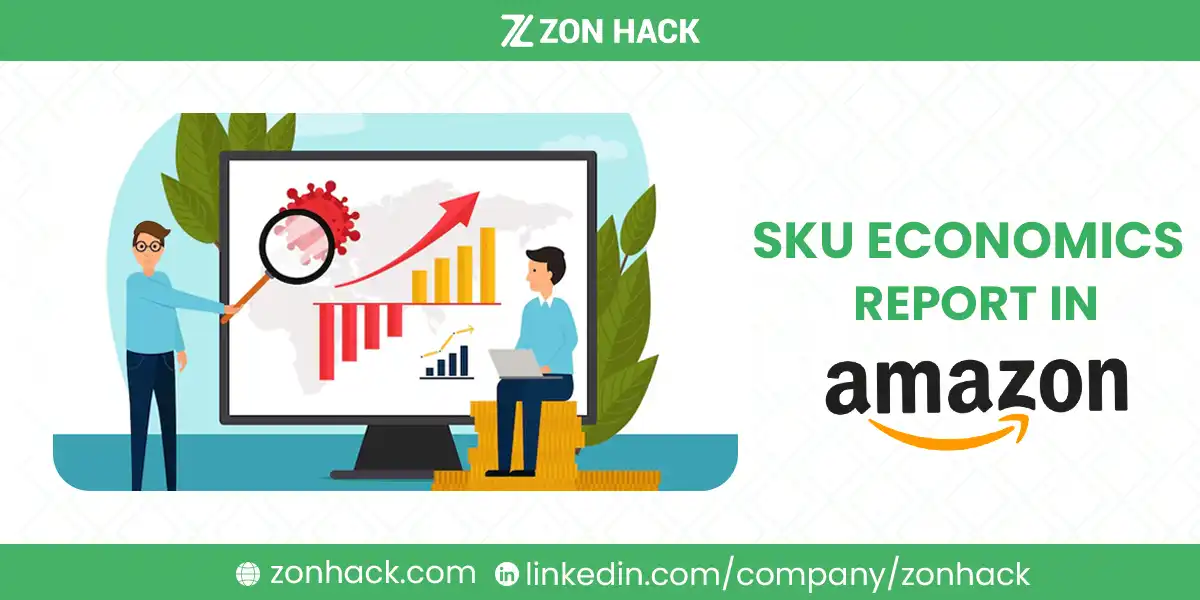As an Amazon seller, understanding your product’s performance is crucial for success. One powerful tool at your disposal is the SKU Economics Report. This report provides a comprehensive breakdown of your product’s financial performance, helping you make data-driven decisions to optimize your business. By understanding this information, sellers can make data-driven decisions to optimize their product selection, pricing strategies, and advertising campaigns. Let’s learn in detail!
What Does SKU Economics Report Mean?
The SKU Economics Report is a detailed financial analysis tool provided by Amazon to sellers. It breaks down the costs, revenue, and profitability of each Stock Keeping Unit (SKU) in your inventory. Think of it as a report card for each of your products, showing you exactly how they’re performing financially.
This report is a goldmine of information for sellers who want to understand their business at a granular level. It’s not just about how much you’re selling, but how much you’re actually making after all the fees and costs are accounted for. Let’s break down what you’ll find in this report.
What Information Does the SKU Economics Report Contain?
The SKU Economics Report is a treasure trove of data, containing a wealth of information about your products’ financial performance. Let’s break down the key components:
Sales Data
This section provides a comprehensive overview of your product’s performance in the market. It includes:
- Average Sales Price: The mean price at which your product is sold.
- Units Sold: The total number of units sold for each ASIN.
- Units Returned: The quantity of products returned by customers.
- Net Units Sold: The number of units sold after accounting for returns.
- Net Sales: Your total sales revenue after deducting returns.
- Total Sales: The gross sales revenue before returns are factored in.
This data helps you understand your product’s market performance and customer satisfaction levels.
Cost of Goods Sold (COGS)
While Amazon doesn’t have information on your specific cost of goods, this is a crucial metric for you to track independently. It includes:
- Manufacturing costs
- Shipping to Amazon’s warehouses
- Any other direct costs associated with your product
Understanding your COGS is essential for calculating your true profit margins.
Fee Data
This section breaks down the various fees Amazon charges, including:
- Referral Fee: The commission Amazon charges on each sale.
- FBA Fulfillment Fee: Charges for using Amazon’s Fulfillment by Amazon services.
- Base Monthly Storage Fee: Costs for storing your inventory in Amazon’s warehouses.
- Inventory Surcharges: Additional fees for aged inventory (over 180 days).
- FBA Inbound Placement Service Fee: Costs related to placing inventory in fulfillment centers.
- Inbound Transportation Charge: Fees for shipping inventory to Amazon’s warehouses.
- Managing Inventory Storage Fee: Additional fees for managing inventory storage.
- Refund Fee: Costs associated with processing refunds.
- AA Disposal Order Fee: Fees for disposing of excess or aged inventory.
Understanding these fees helps you identify areas where you can potentially reduce costs.
Advertising Spend Data
For sellers using Amazon’s advertising platform, this section is crucial. It includes:
- Sponsored Products Ad Fee: Costs associated with your sponsored product listings.
This data helps you evaluate the effectiveness of your advertising campaigns and their impact on your bottom line.
Off Amazon Cost
This column allows you to input any additional costs not covered by Amazon’s data, such as:
- External marketing expenses
- Product photography costs
- Other operational expenses
Storage Fee base rate and surcharges
This section provides a detailed breakdown of storage-related costs:
- Base storage fees
- Long-term storage fees
- Seasonal surcharges
Understanding these fees is crucial for effective inventory management.
Fulfillment base rate and surcharges
For FBA sellers, this section is particularly important. It includes:
- Base Fulfillment Fee: Standard fee for fulfilling orders.
- Surcharges for oversized or special handling items
These fees can significantly impact your profitability, especially for larger or more complex products.
Net proceeds
This is the bottom line – your actual profit per SKU after all costs and fees are deducted from your sales.
How to Get an SKU Economics Report on Amazon?
Accessing this valuable report is straightforward. By following a few steps, you can get the report easily. Here’s a step-by-step guide:
- Log in to your Amazon Seller Central account.
- Click on the Hamburger icon at the top left corner and click on Reports.
- Click on the SKU Economics Report option.
- Configure the report parameters:
- Choose your marketplace
- Select the data aggregation level
- Specify the date range for the report
- Configure the report data:
- Include sales data, PPC data, advertising spend, off-Amazon costs, storage fees, fulfillment base rate, surcharges, and net proceeds
- Add any additional columns if necessary
- Click on Generate Report
- Once generated, download the report from the Reports section
After downloading, open the file to review the aggregated data on fees, costs, and net proceeds for your SKUs.
How to Adjust PPC Campaigns with SKU Economics Report?
The SKU Economics Report is a powerful tool for optimising your PPC (Pay-Per-Click) campaigns. Here’s how you can leverage it:
- Identify Profitable and Unprofitable SKUs:
- Prioritize SKUs with high profit margins and positive ROAS (Return on Ad Spend)
- Re-evaluate or pause campaigns for consistently unprofitable SKUs
- Adjust Bids:
- Increase bids for profitable SKUs to improve visibility
- Decrease bids for unprofitable SKUs to reduce costs
- Optimize Landing Pages:
- Improve conversion rates for profitable SKUs by optimizing product listings
- Refine Targeting:
- Narrow targeting for well-performing SKUs to reach highly relevant audiences
- Consider broadening targeting for struggling SKUs to reach a wider audience
- Leverage Negative Keywords:
- Use negative keywords to prevent ads from showing for irrelevant searches
- Consider Ad Copy:
- Highlight unique selling points of profitable SKUs in your ad copy
- Monitor and Iterate:
- Regularly analyze the SKU Economics Report to identify trends and adjust campaigns accordingly
Remember, PPC optimization is an ongoing process. Continuously monitor your SKU Economics Report and be prepared to adjust your strategy based on the data.
Shortcomings of the SKU Economics Report in Amazon
While the SKU Economics Report is a valuable tool for Amazon sellers, it has some limitations:
- Inaccurate Data: One of the primary shortcomings of the report is its occasional provision of incorrect information. This can include discrepancies in product sell amounts, total sell amounts, and other relevant metrics.
- Ongoing Improvements: Amazon is actively working to address these issues and improve the accuracy of the SKU Economics Report. However, it’s important to be aware of these potential inaccuracies and to verify the data whenever necessary.
To overcome these limitations and calculate accurate profit and loss, sellers can:
- Follow the Amazon Payment Reconciliation method: This method involves reconciling your Amazon seller account’s payments with your bank statements to ensure accurate financial reporting.
- Cross-reference with other data: Compare the information provided in the SKU Economics Report with data from other sources, such as your sales analytics or inventory management systems.
- Exercise caution when making decisions: Be mindful of potential inaccuracies in the report and avoid making significant business decisions solely based on the data it provides.
By understanding these shortcomings and taking proactive steps to verify and reconcile data, sellers can make more informed decisions about their Amazon business and accurately calculate profit and loss.
Conclusion
The SKU Economics Report is a valuable tool for Amazon sellers who want to gain a deeper understanding of their product performance and financial health. By analyzing the data provided in the report, you can identify profitable products, optimize your pricing strategies, make informed decisions about your advertising campaigns, and manage your inventory costs effectively.




